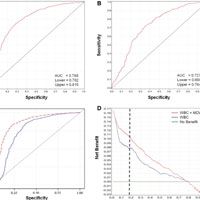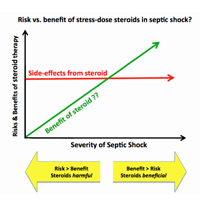Tag: sepsis

Early Goal-directed Therapy Using a Physiological Holistic View
If peripheral perfusion-targeted resuscitation improves 28-day mortality, this could lead to simplified algorithms, assessing almost in real-time the reperfusion process, and pursuing more physiologically sound objectives.... read more

Resuscitation Guided by Volume Responsiveness Does Not Reduce Mortality in Sepsis
The results of this systematic review and meta-analysis indicate that a volume responsiveness (VR) guided resuscitation strategy in sepsis patients confers no mortality benefit compared with usual care. The methods of... read more

State-Mandated Protocolized Sepsis Care Associated with Decrease in Sepsis Mortality
Beginning in 2013, New York State implemented regulations mandating that hospitals implement evidence-based protocols for sepsis management, as well as report data on clinical outcomes to the state government. This study... read more

Speedy sepsis care slows in-hospital mortality
Sepsis and septic shock patients treated within 3 hours had lower in-hospital mortality rates than those treated between hours 3 and 12, based on data from nearly 50,000 adult patients. The findings were presented at an international... read more

qSOFA Performance Score as Prognostic Tool in Infected Patients Outside the ICU
A positive qSOFA score had high specificity outside the ICU in early detection of in-hospital mortality, acute organ dysfunction, and ICU admission, but low sensitivity may have limitations as a predictive tool for adverse... read more

Ideas for Future Intensive Care
Progress toward determining the true worth of ongoing practices or value of recent innovations can be glacially slow when we insist on following the conventional stepwise scientific pathway. Moreover, a widely accepted but... read more

Effective Sepsis Detection with Peripheral Blood Monocyte Distribution
This study evaluated the diagnostic accuracy of peripheral blood monocyte distribution width alone and in combination with white blood cells (WBCs) count for early sepsis detection in the emergency department. An monocyte... read more

Metabolic sepsis resuscitation: the evidence behind Vitamin C
Sepsis resuscitation generally focuses on hemodynamics. Rivers of ink have been spilled writing about oxygen delivery and fluid responsiveness. This is clearly important, but it's possible that our focus on easily... read more

Phenotyping: Need to Identify Subgroups of ARDS Patients
The consensus definitions of acute respiratory distress syndrome (ARDS) mainly rely on feasible clinical criteria, which help to group patients together for inclusion in clinical trials and for clinical management. This generates... read more

Vasopressors and Inotropes for Shock Syndromes
Vasopressors and inotropes are cornerstones in the management of shock syndromes. Understanding vasopressors' receptor activity and resultant pharmacological response enables clinicians to select the ideal vasopressor(s)... read more

Steroids in Septic Shock – Four Misconceptions and One Truth
The utility of steroids in sepsis has been debated passionately for decades. There is hope that steroids might improve mortality, but also fear that they could increase infectious complications. Practice varies widely. What... read more

Sepsis: Personalization vs. Protocolization?
The history of intensive care has been littered with too many false dawns. Old management dogma, now derided, have been replaced by new and equally resolute convictions, many of which will, in time, undoubtedly follow a similar... read more

Variation in Identifying Sepsis and Organ Dysfunction Using Administrative Versus Electronic Clinical Data and Impact on Hospital Outcome Comparisons
Variation in the accuracy of claims data for identifying sepsis and organ dysfunction limits their use for comparing hospitals' sepsis rates and outcomes. Using objective clinical data may facilitate more meaningful hospital... read more

Practical Management of Invasive Candidiasis in Critically Ill Patients
The heterogeneity of this patient population necessitated the creation of a mixed working group comprising experts in clinical microbiology, infectious diseases and intensive care medicine, all chosen on the basis of their... read more








